At around $500, the Intel Xeon Silver 4110 is a thoroughly mainstream part. It features 8 cores / 16 threads along with low power operation. If you are looking for a lower-end server, the Intel Xeon Silver 4110 is going to be a strong option. The pricing of this part makes us pause for a second.
Intel Xeon Silver 4110 versus Intel Xeon E5-2620 V4
An Intel Xeon E5-2620 V4, the previous generation part with the same 2.1GHz base and 3.0GHz turbo clock is about 20% less expensive. It is somewhat strange to see CPUs become more costly over time. Here is the Intel ARK comparison of the two. With the Intel Xeon E5-2620 V4 one had access up to 1.5TB of RAM versus 0.75TB with the Xeon Silver 4110 even though both could handle 12 DIMMs. One gets the newer Lewisberg PCH with the Xeon Silver and 8 extra PCIe lanes. In this segment of the market, very few servers are going to use that many PCIe lanes and more than 512GB of RAM so the limitations are largely moot. Still, this is one of the easiest direct mappings between a Broadwell-EP and Skylake-SP chip we have seen.
Key stats for the Intel Xeon Silver 4110: 8 cores / 16 threads, 2.1GHz base and 3.0GHz turbo with 11MB L3 cache. The CPU features a 85W TDP. This is a price point Intel has maintained for years. Here is the ARK page with the feature set.
Test Configuration
Here is our basic test configuration for single-socket Xeon Scalable systems:
- Motherboard: Supermicro X11SPH-nCTF
- CPU: Intel Xeon Silver 4110
- RAM: 6x 16GB DDR4-2400 RDIMMs (Micron)
- SSD: Intel DC S3710 400GB
- SATADOM: Supermicro 32GB SATADOM
One of the key advantages the Intel Xeon Silver series has is the ability to use up to 12 DIMMs per socket. Intel’s embedded platforms and quad-core Intel Xeon E3-1200 V6 series platforms cannot do this in 2017. DDR4-2400 is the fastest memory supported on the Xeon Bronze platform which is why we are not using faster speeds.
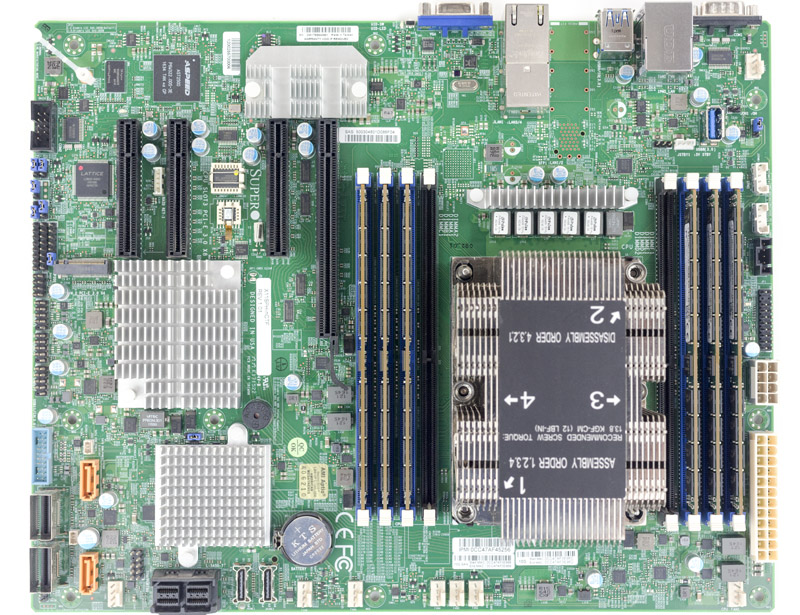
Here is the lscpu output of the chip:

Single Intel Xeon Silver 4110 Benchmarks
For this exercise, we are using our legacy Linux-Bench scripts which help us see cross-platform “least common denominator” results. We do have a full set of expanded benchmarks from our next-gen test suite (Linux-Bench2) so expect to see those results sprinkled in as we get a larger comparison data set built. These results have also been previewed elsewhere, such as the Intel Atom C3955 benchmarks we did so you can see larger data sets in our other reviews. Here we are going to focus on generational performance.
Python Linux 4.4.2 Kernel Compile Benchmark
This is one of the most requested benchmarks for STH over the past few years. The task was simple, we have a standard configuration file, the Linux 4.4.2 kernel from kernel.org, and make the standard auto-generated configuration utilizing every thread in the system. We are expressing results in terms of compiles per hour to make the results easier to read.
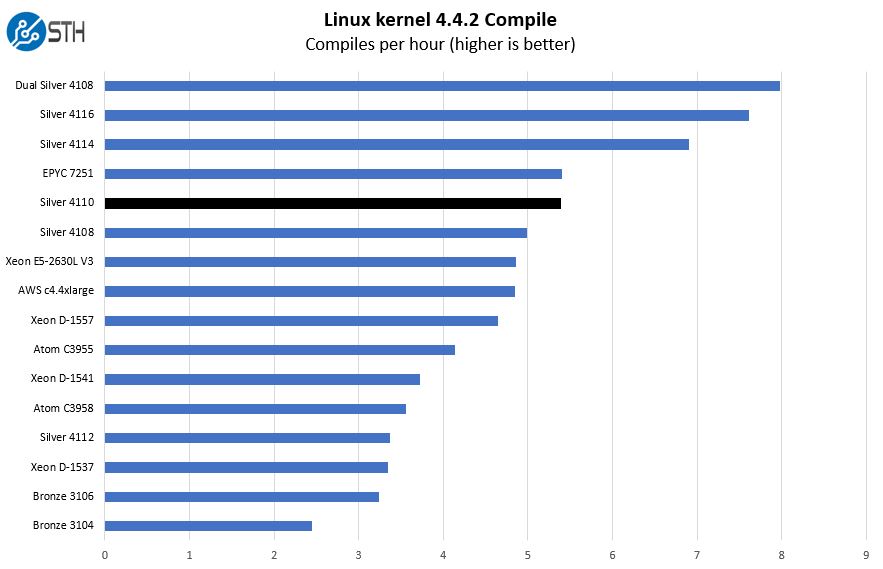
Overall, performance is good. One can see the move to the Silver 4114 is a significant jump and there is a noticeable improvement over the Intel Xeon Silver 4108.
c-ray 1.1 Performance
We have been using c-ray for our performance testing for years now. It is a ray tracing benchmark that is extremely popular to show differences in processors under multi-threaded workloads.
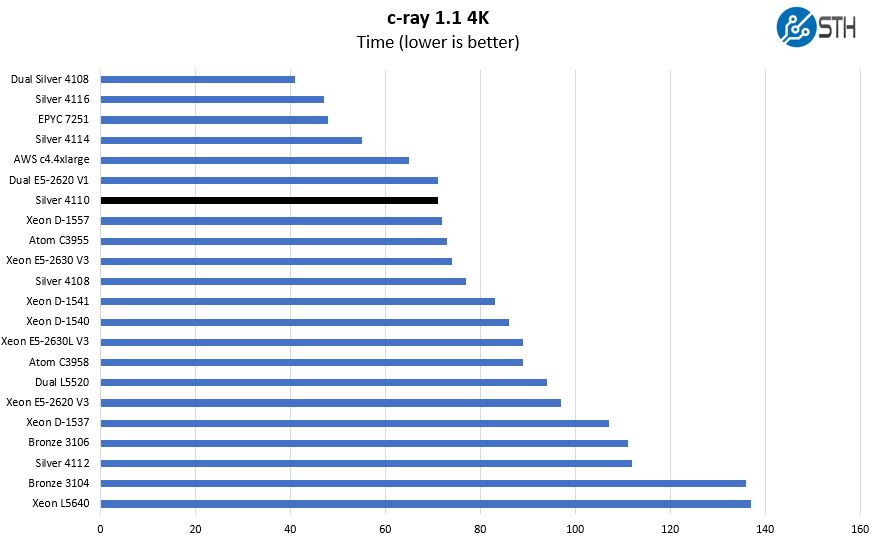
This is an extremely cache dependent workload that AMD performs extremely well with. We wanted to point to the Dual Xeon L5520 and Xeon L5640 results to show just how far we have come in low power performance over the past few generations. These configurations are on their last legs in data centers and one can see why.
7-zip Compression Performance
7-zip is a widely used compression/ decompression program that works cross-platform. We started using the program during our early days with Windows testing. It is now part of Linux-Bench.
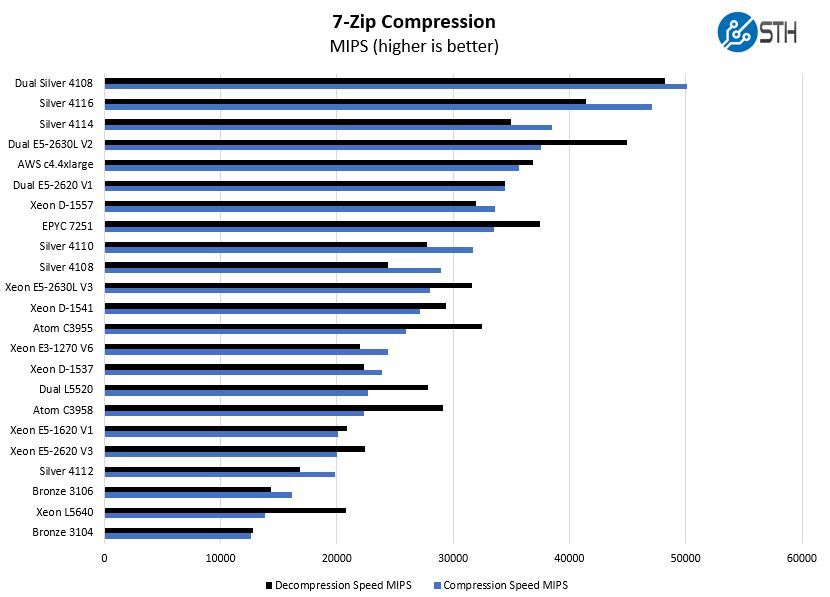
This chart is sorted by compression speed. One can see a nice uptick from the Intel Xeon Silver 4108 and that we are seeing performance along the lines of a 10 core Xeon D from the 8 core Xeon Silver 4110.
NAMD Performance
NAMD is a molecular modeling benchmark developed by the Theoretical and Computational Biophysics Group in the Beckman Institute for Advanced Science and Technology at the University of Illinois at Urbana-Champaign. More information on the benchmark can be found here. We are going to augment this with GROMACS in the next-generation Linux-Bench in the near future. With GROMACS we have been working hard to support Intel’s Skylake AVX-512 and AVX2 supporting AMD Zen architecture. Here are the comparison results for the legacy data set:
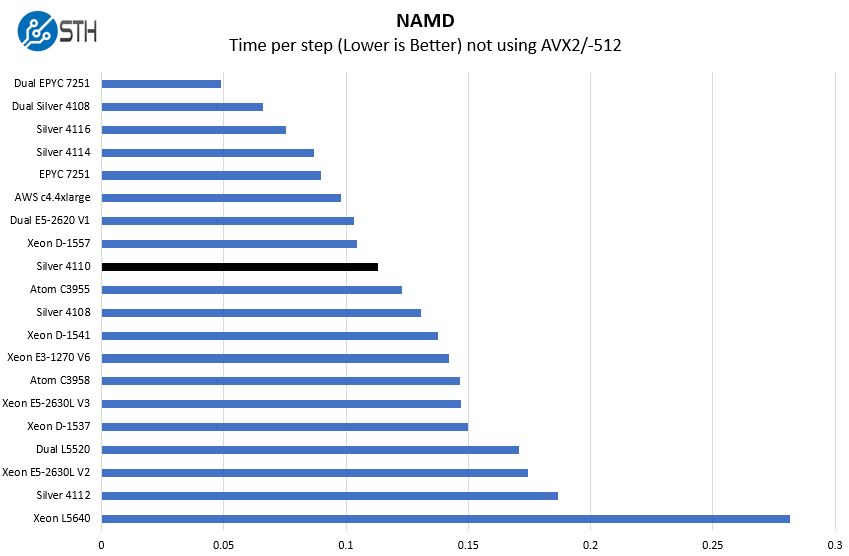
Even the top end 16 core Atom C3955 is no match for the low power 8 core Xeon Silver 4110 here. This is also one area where the AMD EPYC platform performs relatively well.
Sysbench CPU test
Sysbench is another one of those widely used Linux benchmarks. We specifically are using the CPU test, not the OLTP test that we use for some storage testing.
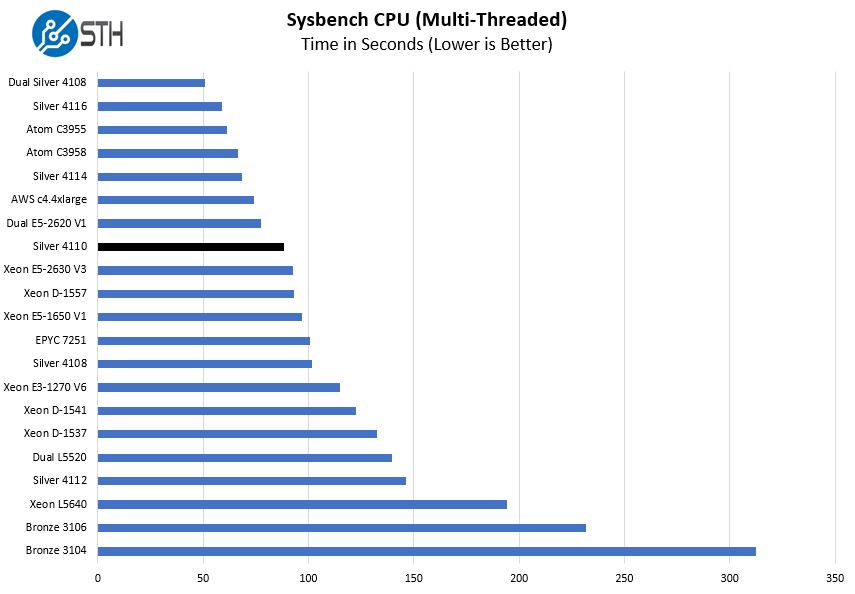
The Sysbench CPU multi-threaded test prefers having more cores. One should not be fooled by the sequentially higher number of the Intel Xeon Silver 4112, the Intel Xeon Silver 4110 has a lot more compute potential than the +2 increment suggests.
OpenSSL Performance
OpenSSL is widely used to secure communications between servers. This is an important protocol in many server stacks. We first look at our sign tests:
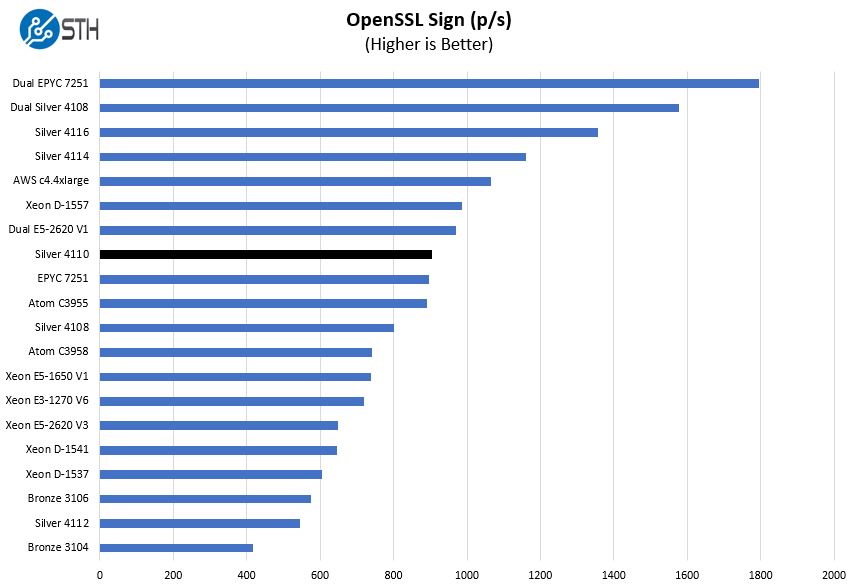
Here are the verify results:
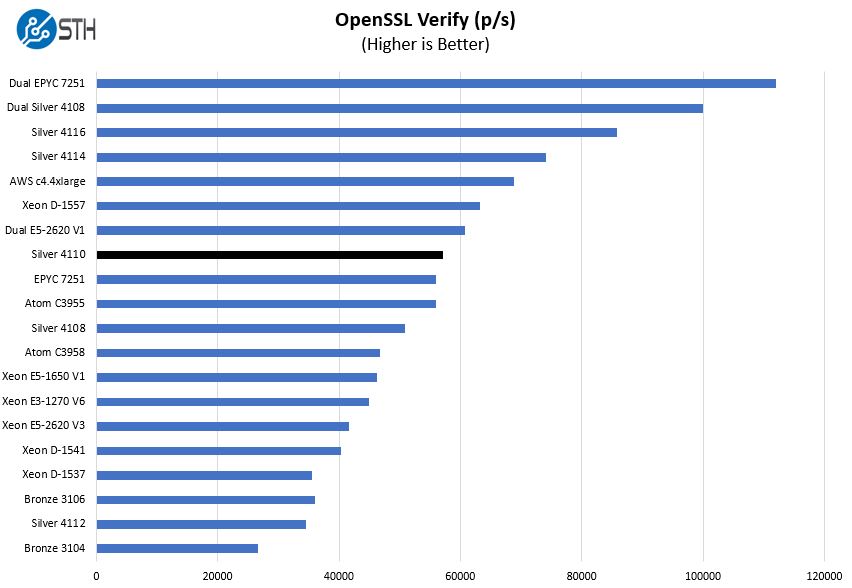
These are results along the lines of what we would expect. For some context, the dual Intel Xeon E5-2620 V1 setup has two 6 core / 12 thread CPUs each with a 95W TDP. If you are moving from Xeon E5 V1 the Intel Xeon Silver 4110 can offer a 2:1 consolidation ratio even at the lower-end of the spectrum.
UnixBench Dhrystone 2 and Whetstone Benchmarks
One longest-running tests is the venerable UnixBench 5.1.3 Dhrystone 2 and Whetstone results. They are certainly aging, however, we constantly get requests for them, and many angry notes when we leave them out. UnixBench is widely used so we are including it in this data set. Here are the Dhrystone 2 results:
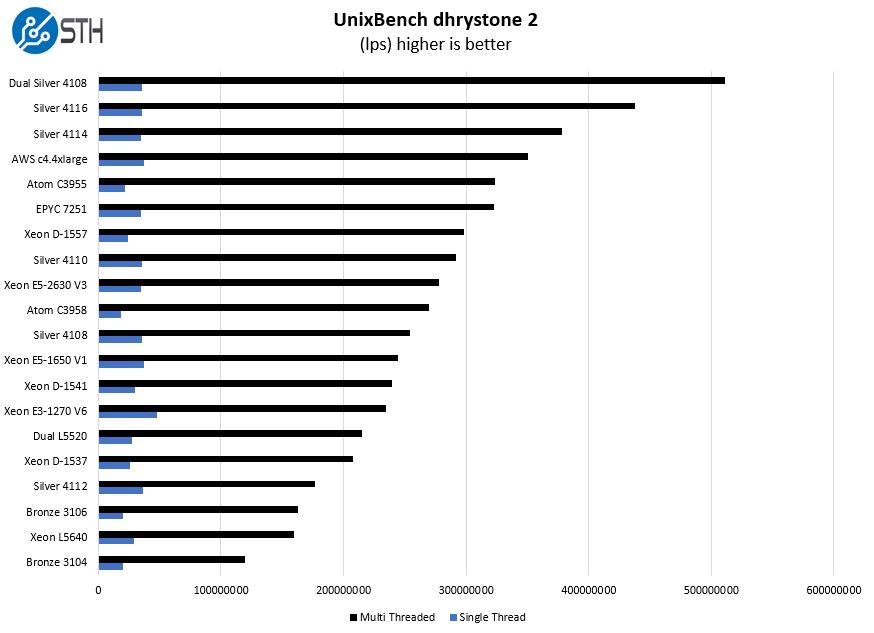
Here are the whetstone results:
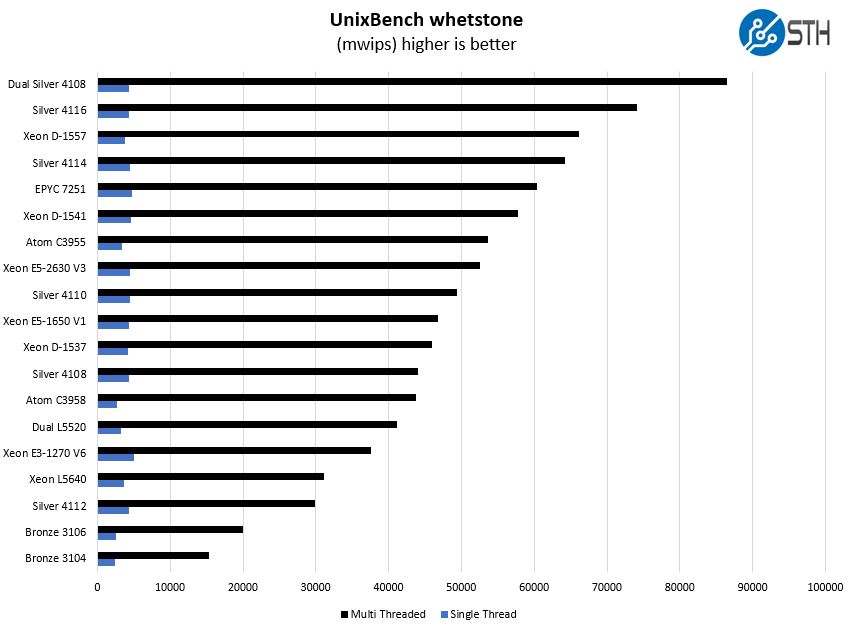
Overall, the results are about what we would expect. One area to note is the Intel Xeon E3-1270 V6 does offer some impressive single thread performance. That single thread performance is the key value proposition of the E3 line (non-GPU enabled) over the Intel Xeon Scalable platform at his point.
GROMACS STH Small AVX2/ AVX-512 Enabled
We have a small GROMACS molecule simulation we previewed in the first AMD EPYC 7601 Linux benchmarks piece. In Linux-Bench2 we are using a “small” test for single and dual socket capable machines. Our medium test is more appropriate for higher-end dual and quad socket machines. Our GROMACS test will use the AVX-512 and AVX2 extensions if available.
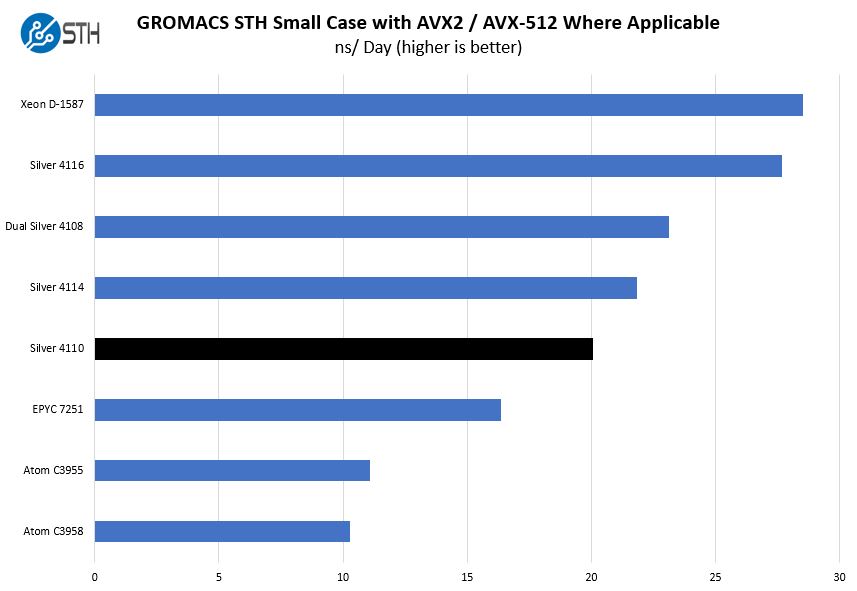
We Pulled a smaller data set here just to give an idea regarding some of the closest competitors. While the Intel Xeon Silver 4110 supports AVX-512, it does not get a major benefit from it. You need to buy into the Intel Xeon Gold 6100 series or above to get the dual FMA AVX-512 which has a demonstrable impact on performance.
Chess Benchmarking
Chess is an interesting use case since it has almost unlimited complexity. Over the years, we have received a number of requests to bring back chess benchmarking. We have been profiling systems and are ready to start sharing results:
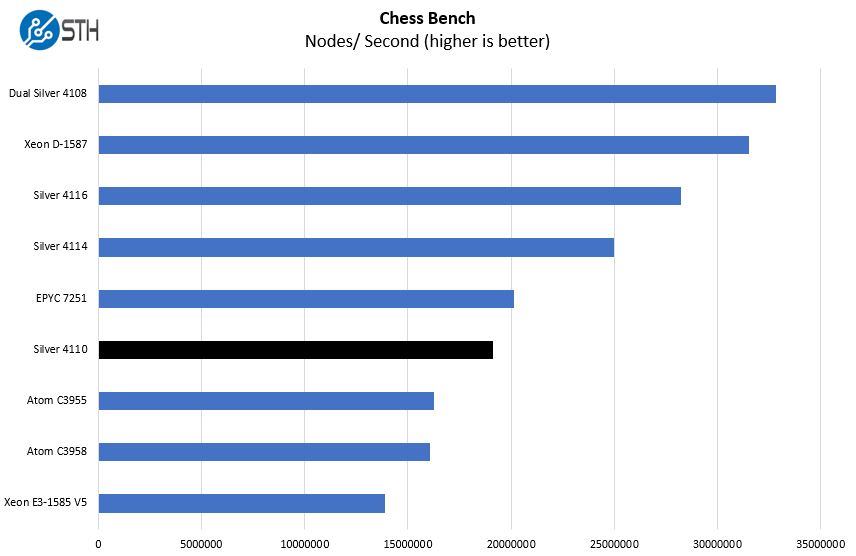
Again, we have solid performance just about on par with the AMD EPYC 7251 system.
Intel Xeon Silver 4110 Power Consumption
We normally only publish power consumption data on full systems we review. There are too many variables for this data to land in a CPU test. At the same time, we wanted to highlight the Intel Xeon Silver 4110 which hit a maximum of around 100W measured at the outlet in our testing. While it may be an 85W TDP part, with 10Gbase-T links active, a SAS 3008 12gbps controller and a number of drives / DIMMs in the system, the TDP rating is significantly higher than actual power consumption.
The impact is clear, one can easily have 1-2 helium-filled hard drives, two SATA DOMs and two SATA/ m.2 SSDs along with 10GbE and the Intel Xeon Silver 4110 in a commodity 1A in 1U colocation hosting on 120V power (drop the hard drives to fit on 110V circuits.) That is quite amazing given the memory bandwidth this has versus other chips in this power range. For applications such as web hosting that are heavily cached in memory, the additional DIMM slots and memory bandwidth are going to make this a winner in the hosting space.
Market Positioning
The Intel Xeon Silver 4110 is an interesting part. It offers no more turbo boost performance (single core) than the Intel Xeon Silver 4108. What one instead gets is higher all core turbo and base frequencies. On an 8 core, low clock speed part that has a perceptible impact on performance. The big question is whether a $100 price difference is warranted. In most servers, this equates to a 10% or less price increase for what is likely to be a 20% or more performance improvement. That is a major reason we like the Silver 4110 over the 4108.
Comparing the Intel Xeon Silver 4110 to the AMD EPYC 7251 seems logical given how close the two chips are in price and given both are 8 core CPUs. The market for these CPUs, in single socket configurations, is generally a narrowly defined space. If one, for example, is building a 24-bay NVMe chassis with $25,000 or more of SSDs, the incremental cost to move up either the AMD or Intel stacks becomes negligible. These CPUs are realistically used in low-end storage servers with a handful of disks, as dedicated web hosting nodes (usually with 64GB or less of RAM) or as network appliances.
Here, we prefer the Intel Xeon Silver 4110 in most of these scenarios because the power consumption is significantly lower than the AMD EPYC. One can fit a cadre of SSDs with 10GbE and still fit even under 1A on 120V power per U. If one wants pure expansion, the AMD EPYC 7251 is a good option but we would suggest moving up the stack anyway.
If you look at the Intel Xeon Silver 4110 as providing solid performance at a low cost for a single socket server, it fills this role extremely well.
Final Words
Intel’s market positioning with the Silver 4110 is clear. It is meant for the low power server segment. The power consumption was a bit of a surprise. Given the TDP of the chip and the platform’s Lewisburg PCH, we were expecting it to use significantly more power than an Intel Xeon D platform. Instead, we find power consumption not that much higher than an Intel Xeon D-1541. What one does get is a significantly more expandable platform with the Xeon Silver.
We will have our dual-socket review in the near future of all of the Intel Xeon Silver parts. We think that the value proposition is slightly different in the dual socket market which warrants significant discussion. If you are just looking for a low-power server, this is a great chip to use. When you look at the lineup the relatively minor price bump from the Intel Xeon Silver 4108 is justified by performance gains. Likewise, the similarly priced Intel Xeon Silver 4112 is no match for the Intel Xeon Silver 4110 performance. Overall, this is a chip we are buying for our infrastructure.

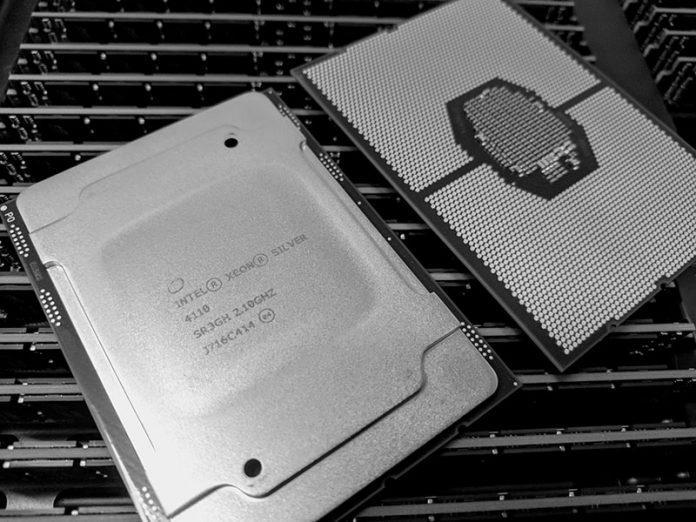



It’s a shame that you didn’t have any results for Intel Xeon E5-2620 V4 to compare it with :(
+1, I am too, expected comparison S4110 with E5-2620v4, because in my view it will be replacement model for popular 2620v4.
Hi – we should have the E5-2620 V4 in our dual socket if I recall correctly. We do not have as much single socket E5 data as we do Xeon Scalable and I do not think we have the E5-2620 V4’s in the lab at the moment.
The Xeon Silver 4110 might also make a good workstation CPU.
Jeff – highly not recommended to use the Silver 4110 as a workstation CPU. There are many better options out there.
What max prime was used in the sysbench tests?
Patrick – with regard to not using the Silver 4110 in a (single socket) workstation CPU, can you suggest what would be the best choices in this price range, please?
Hi John – Xeon W, Xeon E-2100 are both better options for workstations at this point (November 2018.) Our forums are also a good place to see what others are using.
Hi Patrick,
Could you elaborate further on why this wouldn’t make a good workstation CPU? I’m looking at getting a new machine that has two processor sockets, and this seemed like an ideal CPU for the first slot. I was planning to get a second one later and I know this Xeon should allow for that. Thanks
Stan, you want higher clock speeds on a workstation. 3.0GHz maximum is very low by modern standards.
Can someone explain why lscpu says 32 CPUs? I have the same CPU and mine says 16. 8 cores, 2 threads per core, should be 16? Which distro/ver did you use? Thanks
Jonathan D – looks like misreporting # of sockets. That was from a dual socket machine.